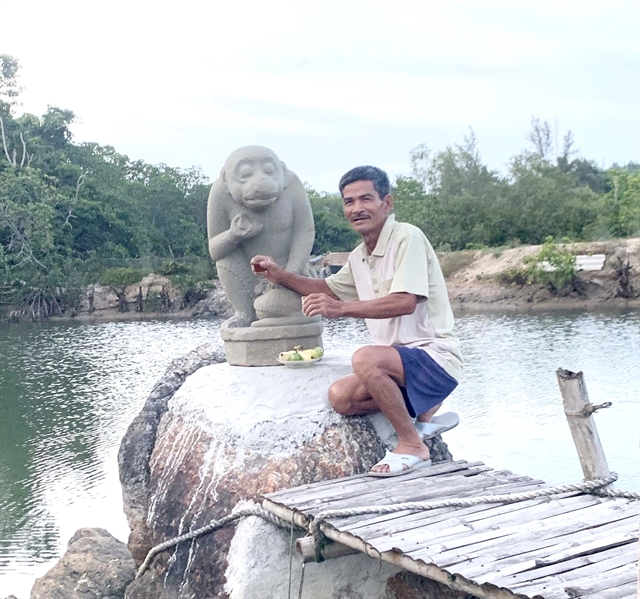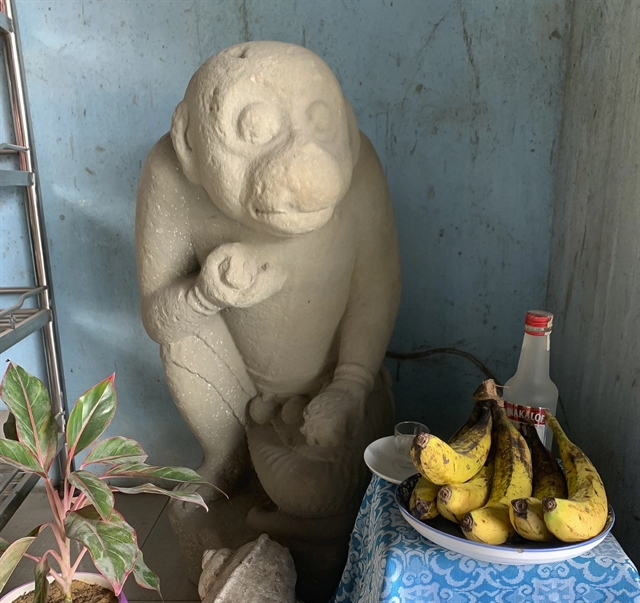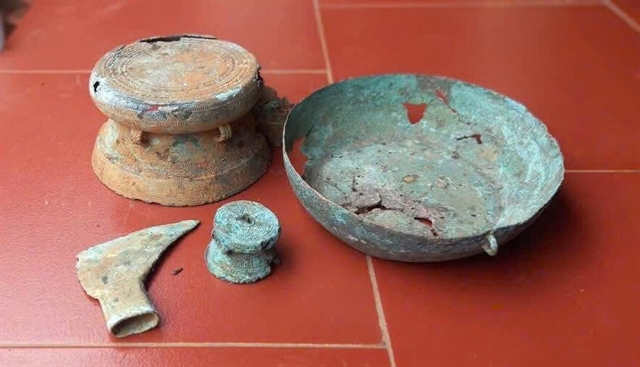Two villagers have handed over precious items to local museums for future preservation and research.

Dương Đình Lục pictured with the statue of the monkey deity he found. — VNA/VNS Photo
QUẢNG NGÃI — A local fisherman in the central province of Quảng Ngãi has given a statue of a monkey deity believed to be from the 11th century to the Quảng Ngãi Provincial Museum, according to museum director Nguyễn Văn Thành.
The artefact, a statue of the monkey deity Hanuman, was discovered and voluntarily submitted by Dương Đình Lục, a resident of Tuyết Diêm 3 Village in the province's Vạn Tường Commune. The artefact is made of carved stone, weighs 150kg, and has been attributed to the Champa culture of the 11th-12th century.
Lục said he discovered the stone statue of a monkey at a depth of 2-4 metres, about 50 metres offshore while fishing in the waters of Vũng Buồn Bay in early 2021.

The statue was used for worship at Dương Đình Lục's house for a few years before it was donated to the museum. — Photo courtesy of Dương Đình Lục
Since his discovery, the fisherman kept the statue at his own house, where it drew many visitors. According to Lục, some of the visitors even offered to buy it from him for up to VNĐ2 billion (US$76,000), but he refused to sell it. In 2023, local authorities encouraged him to donate the artefact for research and preservation purposes.
Museum Director Thành said the chairman of the Quảng Ngãi Province People's Committee issued Official Letter 653/QĐ-UBND on August 20, approving the plan to establish public ownership rights for the artefact.
The museum has established an appraisal council, which found that the Hanuman statue is made of fine-grained sandstone, measures 84cm in height and 40cm in width, and weighs 150kg. The monkey deity is portrayed in a seated position on an octagonal stone base that is 14cm high, with the figure itself measuring 70cm.
Details including the rounded head, protruding eyes, high nose, wide mouth and circular patterns with bell-like decorations around the belly reflect the style of late Champa sculpture, while also showing influences from Khmer art.
The sculpture of Hanuman is fairly large and well preserved, thus holding significant value. Researchers believe that the artefact may originate from the Chánh Lộ tower ruins, where hundreds of Champa sculptures were excavated in 1927.
According to a cultural researcher in Quảng Ngãi, the monkey statue is a relic that reflects about 800 years of cultural development within the historical context of the Champa - Đại Việt culture.
It possesses features of Champa stone sculpture and illustrates religious themes influenced by India. These values indicate that it is a unique artefact with historical and cultural significance for Quảng Ngãi, necessitating further research, preservation and display for public appreciation.
Phú Thọ bronzes
Meanwhile, Chairman of the Vân Bán Commune People's Committee in the northern province of Phú Thọ Bùi Bá Lạc has also announced that a local family has handed over several valuable artefacts from the Hùng King era.

Nguyễn Hữu Long (fourth from left) hands over an artefact to local authorities. —Photo tienphong.vn
The rare and ancient items, comprising two bronze drums, one square-headed axe and one bronze container believed to date back to more than 2,500 years ago, were discovered by villager Nguyễn Hữu Long in 2024 while gardening.
Long and his family have donated them to the Phú Thọ Province Museum to educate the public, and particularly younger generations, about the traditional cultural values of the Hùng King era.
After the artefacts' discovery, Long and his family recognised their potential historical significance and carefully preserved them for display.
They then decided to donate the entire collection to the local government to support research and exhibition efforts, thereby spreading heritage value to the community.

The artefacts belong to the Đông Sơn culture, dating back over 2,500 years. —Photo tienphong.vn
An initial survey concluded that the artefacts belong to the Đông Sơn culture, dating back over 2,500 years. These are rare items with significant historical and cultural value.
“The timely reporting and handover of the artefacts by Long's family is highly praised, reflecting a commendable sense of responsibility and awareness in protecting cultural heritage,” said Lạc.
“The Phú Thọ Province Museum will preserve and display these artefacts, contributing to the education of historical and cultural traditions for future generations.
“This also provides an important basis for researchers and community study, thereby ensuring the sustainable preservation and promotion of ethnic cultural heritage values.” — VNS